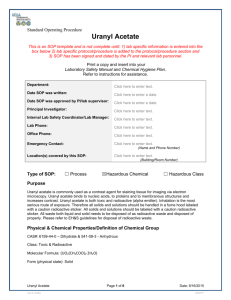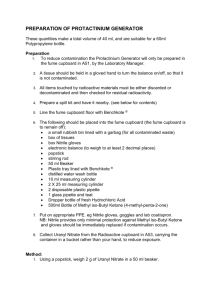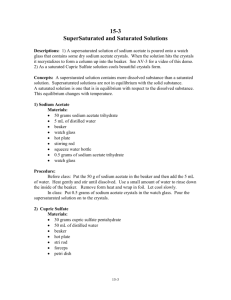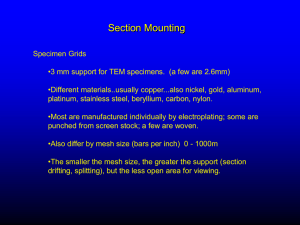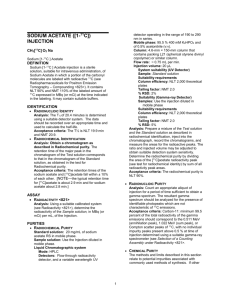Uranyl Acetate - OSEH - University of Michigan
advertisement
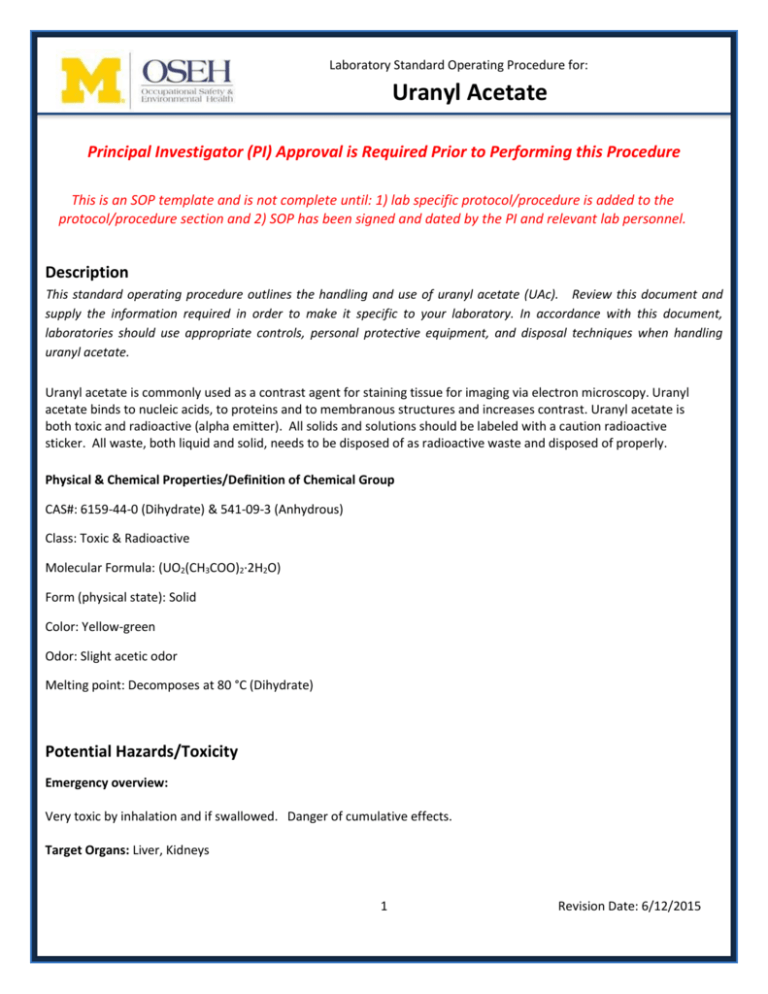
Laboratory Standard Operating Procedure for: Uranyl Acetate Principal Investigator (PI) Approval is Required Prior to Performing this Procedure This is an SOP template and is not complete until: 1) lab specific protocol/procedure is added to the protocol/procedure section and 2) SOP has been signed and dated by the PI and relevant lab personnel. Description This standard operating procedure outlines the handling and use of uranyl acetate (UAc). Review this document and supply the information required in order to make it specific to your laboratory. In accordance with this document, laboratories should use appropriate controls, personal protective equipment, and disposal techniques when handling uranyl acetate. Uranyl acetate is commonly used as a contrast agent for staining tissue for imaging via electron microscopy. Uranyl acetate binds to nucleic acids, to proteins and to membranous structures and increases contrast. Uranyl acetate is both toxic and radioactive (alpha emitter). All solids and solutions should be labeled with a caution radioactive sticker. All waste, both liquid and solid, needs to be disposed of as radioactive waste and disposed of properly. Physical & Chemical Properties/Definition of Chemical Group CAS#: 6159-44-0 (Dihydrate) & 541-09-3 (Anhydrous) Class: Toxic & Radioactive Molecular Formula: (UO2(CH3COO)2·2H2O) Form (physical state): Solid Color: Yellow-green Odor: Slight acetic odor Melting point: Decomposes at 80 °C (Dihydrate) Potential Hazards/Toxicity Emergency overview: Very toxic by inhalation and if swallowed. Danger of cumulative effects. Target Organs: Liver, Kidneys 1 Revision Date: 6/12/2015 Personal Protective Equipment (PPE) Hand Protection Nitrile gloves are recommended with Uranyl Acetate. NOTE: Consult with your preferred glove manufacturer to ensure that the gloves you plan on using are compatible with Uranyl Acetate. Refer to glove selection chart from the links below: http://www.ansellpro.com/download/Ansell_8thEditionChemicalResistanceGuide.pdf OR http://www.allsafetyproducts.biz/page/74172 OR http://www.showabestglove.com/site/default.aspx OR http://www.mapaglove.com/ Eye Protection Safety glasses – ANSI approved Skin and Body Protection Lab coats must be worn. These laboratory coats must be appropriately sized for the individual and be buttoned to their full length. Laboratory coat sleeves must be of a sufficient length to prevent skin exposure while wearing gloves. Full length pants and close-toed shoes must be worn at all times by all individuals that are occupying the laboratory area. The area of skin between the shoe and ankle should not be exposed. Respiratory Protection Respirators should be used only under any of the following circumstances: As a last line of defense (i.e., after engineering and administrative controls have been exhausted). When Permissible Exposure Limit (PEL) has exceeded or when there is a possibility that PEL will be exceeded. There is potential for harmful exposure due to an atmospheric contaminant (in the absence of PEL) As PPE in the event of a chemical spill clean-up process Lab personnel intending to use/wear a respirator mask must be trained and fit-tested by OSEH. Hygiene Measures Wash your hands immediately with warm water and soap after handling Uranyl Acetate. Dispose of contaminated PPE as radioactive waste. Engineering Controls and Use Requirements All work must be performed in a fume hood while the compound is in a powder form since inhalation is the most serious route of entry. This includes making stocks solutions. Once in solution, the material can be used on a bench top. Mark areas where uranyl acetate is used (benchtops, fume hoods) with radioactive warning tape. Do not work in unmarked areas. You must work on top of absorbent paper to protect area from contamination and to contain small spills. 2 You must wear a lab coat, disposable gloves, and safety glasses (or goggles) whenever handling UAc. You must label all bottles, tubes, flasks, etc. containing UAc with radiation warning tape. Also mark them with the words “uranyl acetate”. UAc waste liquids must be collected in the radioactive liquid waste carboy. UAc contaminated solid items must be placed in the radioactive solid waste container. Clean work area immediately after use of uranyl compounds: Gather and dispose, as radioactive wastes, all potentially contaminated wastes (e.g. gloves, bench paper, disposable containers, residual solutions). Gently clean work areas using paper towels dampened with soap and water. Dry completely. Dispose of cleaning materials as radioactive wastes. Store all unused uranyl stocks and solutions in appropriate and labeled containers. The following section in red is an example to follow when writing your lab-specific SOP for using uranyl acetate. Following this section is a section to document training. Be sure to complete all sections. Protocol/Procedure Amount Covered by this SOP: 0-25 grams 0-50 ml diluted to a concentration of 0-10% uranyl acetate Temperature Range: 2°C - 50°C (36oF – 122°F) The following are several examples of how to make uranyl acetate solutions at 2% and 4%. Please refer to your staining protocol to determine which concentration is most appropriate for your tissue. As an example listed below are some staining protocols using these varying concentrations. All solutions and staining procedures should be conducted in a fume hood labeled with a caution radioactive sticker. All solid and liquid waste that comes into contact with uranyl acetate must be disposed of as radioactive waste. Please refer to RSS and HazMat guidelines for appropriate disposal of radioactive waste. Preparation of 2% uranyl acetate solution in double distilled water (ddH2O) 1. Measure out 100 mL of ddH2O and pour into 150mL beaker. 2. Measure 2 g of Uranyl acetate from a 25 g reagent bottle and pour carefully into beaker with ddH2O. 3. Stir solution for at least 15 minutes. 4. Dispose of unused uranyl acetate as liquid radioactive waste. Staining procedure using 2% uranyl acetate 1. Using a disposable plastic pipette, add a drop of uranyl acetate solution onto a sheet of parafilm. 2. Immerse tissue sections into uranyl acetate drop for 4 minutes. 3. Remove sections from uranyl acetate solution and rinse with water. 4. Dispose of parafilm and plastic pipette as solid radioactive waste. 5. Dispose of remaining uranyl acetate solution as liquid radioactive waste. Preparation of a 4% Uranyl acetate solution in Methanol 1. Measure out 100mL of Methanol and pour into 150mL beaker. 2. Measure 4g of Uranyl acetate from a 25 g reagent bottle and pour carefully into beaker with methanol. 3 3. 4. Stir solution for at least 15 minutes. Dispose of unused uranyl acetate as liquid radioactive waste. Staining procedure using 4% uranyl acetate in methanol using freeze substitution 1. Turn on freeze system equipment and set temperature to -90°C 2. Place tissue sections into capsules. 3. Add 4% uranyl acetate solution into equipment chamber 4. Place capsules with tissue sections into uranyl acetate filled chambers and incubate for 2-3 days 5. Remove sections from chamber and remove uranyl acetate solution. 6. Dispose of uranyl acetate solution as liquid radioactive waste. 7. Add HM20 resin solution to chamber and return sections. 8. Leave sections in chamber for 2 – 3 days. 9. Remove sections from chamber and solution. First Aid Procedures If inhaled Remove to fresh air. If breathing becomes difficult, seek medical attention. In case of skin contact Wash immediately with plenty of soap and water. In case of eye contact Flush eyes with large amounts of water for at least 15 minutes, occasionally lifting upper and lower eyelids. If swallowed If person is conscious, wash out mouth with water. Seek medical attention. Special Handling and Storage Requirements Handling: Avoid inhalation and contact with eyes, skin and clothing. Avoid prolonged ore repeated exposure. Storage: Store in cool, dry place in tightly closed container. Conditions to Avoid: Protect from moisture. Incompatibility with Other Materials: Oxidizing agents. NOTE: Consider it like a radioactive chemical. Only trained and authorized personnel can handle the container. Waste Disposal Uranyl acetate waste is considered radioactive waste, solid or liquid. Handle and store hazardous waste following the guidelines above for work practice controls, transportation and storage. Because most spent, unused and expired chemicals/materials are considered hazardous wastes, they must be properly disposed of. Do not dispose of chemical wastes by dumping them down a sink, flushing in a toilet or discarding in regular trash containers, unless authorized by OSEH Hazardous Materials Management (HMM). Contact OSEH-HMM at (734) 763-4568 for waste containers, labels, manifests, waste collection and for any questions regarding proper waste disposal. Also refer to OSEH’s Hazardous Waste webpage for more information. 4 Exposures/Unintended Contact If the employee is in need of emergency medical attention, call 911 immediately. For an actual chemical exposure/injury: Remove contaminated clothing. Flush exposed eyes or skin with water for at least 15 minutes. Seek medical attention (see below). For situations with risk of inhalation exposure, remove all persons from the contaminated area. If an ambulance is needed, call the University of Michigan Police Department (UMPD) at 911 to request assistance. Contact OSEH for advice on symptoms of chemical exposure, or assistance in performing an exposure assessment. Report all work related accidents, injuries, illnesses or exposures to WorkConnections within 24 hours by completing and submitting the Illness and Injury Report Form. Follow the directions on the WorkConnections website Forms Instructions to obtain proper medical treatment and follow-up. Complete the OSEH Laboratory Incident and Near-Miss Report form. TREATMENT FACILITIES: U-M Occupational Health Services -- Campus Employees Mon-Fri 7:30 am - 4:30 pm After hours - go to UM Hospital Emergency Dept. – Urgent Care Clinic C380 Med Inn building 1500 East Medical Center Drive, Ann Arbor (734) 764-8021 University Health Services -- University students (non-life threatening conditions) Mon-Fri 8 am – 4:30 pm, Sat 9 am – 12 pm Contact for current hours as they may vary 207 Fletcher Street, Ann Arbor (734) 764-8320 UMHS Emergency Department -- after clinic hours or on weekends 1500 East Medical Center Drive, Ann Arbor, (734) 936-6666 For more information in case of emergency, click here. Spill Procedure When a spill occurs, personal safety should always come first. Alert and clear everyone in the immediate area where the spill occurred. Assess the extent of danger. Help contaminated or injured persons. Avoid breathing vapors. If possible, confine the spill to a small area using a spill kit or absorbent material. Keep others from entering contaminated area (e.g., use caution tape, barriers, etc.). 5 If you have training, you may assist in the clean-up effort. Use appropriate personal protective equipment and cleanup material for chemical spilled. Double bag spill waste in clear plastic bags, label and take to the next chemical waste pick-up. Chemical Spill on Body or Clothes – Remove clothing and rinse body thoroughly in emergency shower for at least 15 minutes. Seek medical attention. Chemical Splash Into Eyes – Immediately rinse eyeball and inner surface of eyelid with water from the emergency eyewash station for 15 minutes by forcibly holding the eye open. Seek medical attention. Additional Spill Links: www.oseh.umich.edu/pdf/chemspil.pdf www.oseh.umich.edu/emer-chemical.shtml. Report all emergencies, suspicious activity, injuries, spills, and fires to the University of Michigan Division of Public Safety and Security (DPSS) by calling 911 or texting 377911. Register with the University of Michigan Emergency Alert System via Wolverine Access. Documentation of Training (signature of all users is required) Training of Personnel All personnel are required to complete the General Laboratory Safety Training session (BLS025w or equivalent) via OSEH’s My LINC website. Furthermore, all personnel shall read and fully adhere to this SOP when handling uranyl acetate. Certification I have read and understand the above SOP. I agree to contact my Supervisor or Lab manager if I plan to modify this procedure. Name Signature UM ID # Principal Investigator Date Revision Date 6

